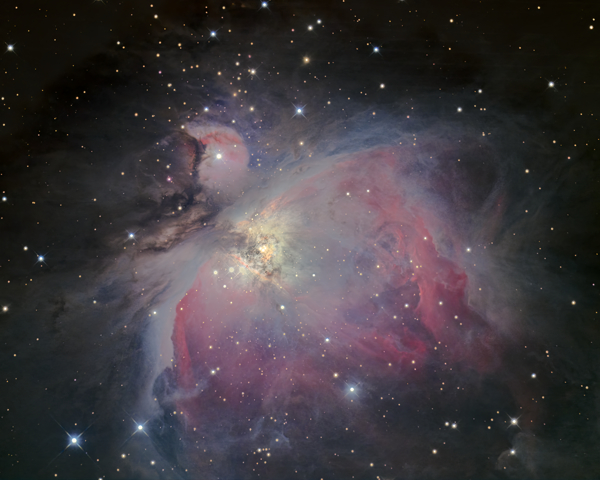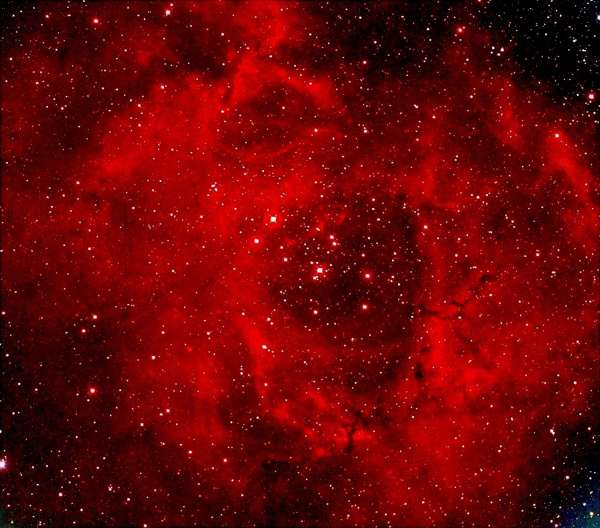These are our observations of Emission-nebula
-
A Bit of Fun with M42
I suspect the Orion Nebula, M42, is the most popular target in the beginner astro-imager's sky. So it is not a target I would normally share; I'm sure you've seen many versions. However, here are a couple of images with a bit of a story of me continuing to learn and change.
I'm a member of a small team of astronomers doing online outreach for the Cambridge Institute of Astronomy (IOA). Since lockdown, each clear Wednesday evening during the winter months, we will attempt to observe and present online, objects of particular interest in the night sky, often related to the subject of a talk. This activity certainly tests the mettle of my ability to find and present images of objects quickly and demands the best performance from my equipment.
Last year, therefore, I purchased a ZWO ASI 294 MC Pro camera and Sharpcap to provide colour images quickly with Sharpcap providing imaging stacking in real-time. I've found it to be an excellent electronically assisted astronomy (EAA) tool and it has transformed my enjoyment of observing to one with a more real-time appreciation of objects, as opposed to extended sessions of imaging a single object with my QSI CCD camera.
M42, of course, has been one of our Wednesday evening targets and I've been astonished at the deep contrast between the brightness of the Trapezium core and the much fainter outer reaches of the nebula.
Once our online session had ended, I set about exploring what the ZWO camera could do with the subject. I gathered a range of exposures ranging between 100 x four seconds and 10 x five minutes and then blended the images together in Photoshop. I have two images to share.
The first is of the Trapezium region using exposures ranging from four seconds to two minutes and blending the images to provide a high dynamic range view. Many of the fainter stars in the Trapezium region are well shown but my telescope is not big enough to separate stars e, f and g in the Trapezium.

An image of the Trapezium region using exposures ranging from four seconds to two minutes blended to provide a high dynamic range by David Davies and taken from Cambridge in the UK. To see more of David's work please visit his Flickr Photostream. Click on the image for the larger version. The second image also blends the five minutes exposures of the outer regions of the nebula and shows well the convoluted gas clouds of emission and reflection that are sculpted by the newly born stars at the core.

An image of Messier 42 by David Davies and taken from Cambridge in the UK. To see more of David's work please visit his Flickr Photostream. Click on the image for the larger version. Image Details
RGB exposures: 4 secs, 30 secs, 120 secs and 300 secs.
- Telescope: 200mm Ritchey-Chretien plus a 0.7x reducer to give 1160mm focal length at F/5.8
- Camera: ASI ZWO 294 MC Pro
- Mount: Skywatcher EQ8
- Software: Sharpcap, Deep Sky Stacker, Pixinsight, Photoshop, Capture One, Topaz Studio 2, Topaz Denoise AI
David Davies - (20 January 2022).
-
NGC 2237 in Monoceros
I took this last night, but the camera was not cooled, I forgot to set it, think it was the excitement of a clear night!! My observatory is in my back garden in Boughton which is on the edge of Northampton.

The Rosette nebula (NGC 2237) by Richard Weatherley taken from Northampton. Image Details
It is a 500 second single shot, which has been slightly cropped, taken with a FLI microline colour using sparse configuration in full frame. The result is processed in Maxim.
- Telescope: AG14 Orion F 3.8
- Camera: FLI Microline Camera
Richard Weatherley - (3 January 2022).
-
NGC 7538 in Cepheus
It's been a while since I shared an astrophotography image with you. Indeed, I think my last one was in April.
During April, my suspicions that something was seriously amiss with my EQ8 mount were confirmed and resulted in a complete dismantle and rebuild with parts repaired and other parts replaced as upgrades. The work took until late July when I was able to start re-tuning the mount and working with some new software tools.
This image, therefore, represents my return to imaging with the repaired equipment.
I selected NGC 7538, Sh2-158 as my target. This is quite a small but very attractive star-forming region in Cepheus is around 9,100 light-years from us. It has been reported to contain the largest protostar system observed to date, around 300 times the size of our solar system. It is not frequently imaged as most prefer to concentrate on its brighter and showier close neighbour, the Bubble Nebula.

This image of NGC 7538 in Cepheus was provided by David Davies and taken from Cambridge in the UK. To see more of David's work please visit his Flickr Photostream. Click on the image for the larger version. Image Details
The image data was gathered during September 2021 and comprises nine hours of LRGB data, with two hours each of RGB in 10-minute subs and three hours of luminance data, also in 10-minute subs all binned 1x1.
- Telescope: 200mm Ritchey-Chretien, Lodestar off axis guider.
- Camera: QSI 683 with Astrodon filters.
- Mount: Skywatcher EQ8.
David Davies - (7 October 2021).